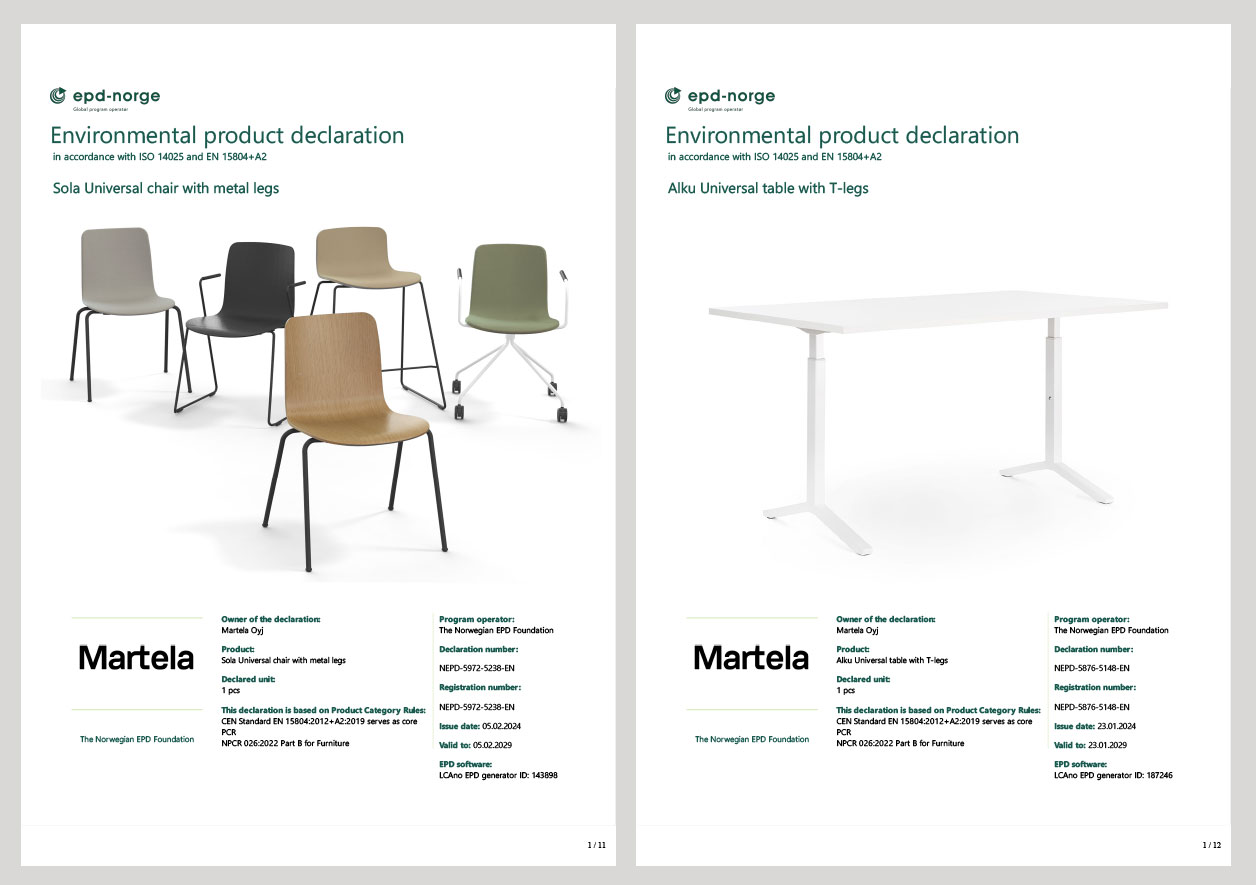Martela has published its first EPD documents
Martela has published its first EPD (Environmental Product Declaration) documents, verified by an independent third party, in December 2023. EPD is a third-party verified standardised document published in a public database. Martela has chosen EPD Norge portal as its publication platform. By the end of February 2024, seven documents have been published, covering a wide range of products including the Sola chair family, Alku table series, as well as Combo and Cupio storage units.

The Environmental Product Declaration is one of the most important practical tools in promoting sustainable development and mitigating climate change. Customers can utilise the reliable environmental impact information contained in the declarations to make sustainable choices and report them to their own customers and building users.
For Martela, creating new EPDs is a significant investment both financially and in terms of resource utilisation. This investment represents another step forward in Martela's strategic direction towards managing environmental impacts throughout the value chain. Only with increasingly accurate information can development be assessed and directed in the right direction.
The new EPDs are a continuation of our carbon footprint calculations
Martela has been involved in a research project aimed at environmental declarations since 1995. Participation in this research project provided a good overview of the overall environmental impacts of selected product types. New methods for assessing environmental impacts of products were developed in the early 2000s. Therefore, in 2010, Martela commissioned Aalto University to conduct a life cycle analysis focusing on carbon footprint for selected products.
Since 2013, Martela has calculated the carbon footprint of its products using a calculation tool developed by an expert company. The creation of the tool, the definition of the scope of the calculation, and the assessment of the coverage and quality of emission factors and consumption data have followed the principles described in the GHG Protocol. The calculation includes direct emissions from our operations (Scope 1), purchased energy (Scope 2), and emissions from the production chain (Scope 3).
The ultimate purpose of various environmental impact reports for all products is to serve as a practical tool to facilitate the selection of products in line with sustainable development. Responsible choices are essential for mitigating climate change. Unfortunately, there is no single method for investigating and communicating the impacts of products, and not all procedures are suitable for all products or raw materials.
Methods are constantly being developed to meet different needs, and the analysis methods used in them are evolving. At present, most calculations are based on a sum of precise information on the final stages of product manufacturing and general coefficients used in the materials. The wider the range of the product's value chain is controlled by the calculator, the more accurate information about the product can be covered through the calculation. Therefore, it is important to understand what information has been available for calculation and on what principles the calculation has been delimited.
The EPD document contains a lot of information
The content of the Martela’s EPD is based on the standard EN15804+A2:2019, and the calculation often uses the general material coefficients of the Ecoinvent database. If a material or component supplier has made its own EPD calculation, it can be used as the basis for the calculation. Since EN15804+A2:2019 is the environmental declaration standard for construction materials, both the material and the component must be intended for construction use so that the starting point for its environmental declaration would be the same standard.
The EPD document is based on a Life Cycle Assessment (LCA) covering the entire life cycle of the product. The EPD includes numerous indicators of environmental impacts and resource use from raw material procurement, processing, and transport to the factory, continuing to production and delivery of the product to the customer. The calculation also includes post-use dismantling, transport, material handling, recycling, and disposal. In terms of life cycle, the tool also takes into account the environmental impacts arising from the use and disposal of the product. Environmental impacts include not only carbon footprint but also scientifically calculated effects related to air, water, and soil. There are various environmental impact categories such as global warming potential (GWP), stratospheric ozone depletion (ODP), and photochemical oxidation (POCP). However, most people primarily look at the climate impact potential found in the final part of the document, which corresponds mainly to the result of carbon footprint calculations.
The requirements of the previous standard version covered a smaller part of the product's life cycle, and therefore the results are not comparable to the calculations according to the revised standard EN15804+A2:2019, which have mainly been published in the latter part of 2023. EPD Norge portal has been publishing EPD calculations for furniture for years according to the previous EN15804:2012+A1:2013 standard version.
More information:
Tiina Bordi
Sustainability Manager, Martela
tiina.bordi@martela.com
+358 50 576 7167
